In a competitive holiday season landscape, leading retailers are turning to scarcity marketing and hype building to capture attention, nurture loyalty, and boost sales. Discover how shopping events are key to generating loyalty, and 6 strategies for flash sale and product drop success.
Black Friday is the biggest day of the year for online retailers. But how can brands attract and retain customers in an uncertain landscape where thousands of competitors are just a click away?
In a competitive holiday season landscape, leading retailers are capturing attention, sales, and loyalty by leveraging the power of shopping events infused with scarcity and hype.
Whether it’s member-only sales, hyped limited-edition product drops, or influencer marketing flash sales, these strategies keep retailers top-of-mind and customers coming back for more.
But what do brands need to know to get these high-stakes sales right?
Discover why the changing holiday landscape favors scarcity and hype; the power of shopping events, memberships, and loyalty-generating strategies; and 6 steps to generate hype and deliver on demand this Black Friday and holiday season.
Table of contents:
There are three key changes transforming the holiday season landscape into one that favors scarcity and hype.
1. The growth of ecommerce
Last year, ecommerce accounted for almost 19% of global retail sales. For years now, ecommerce has grown at a rate of around 15% annually.
The growth of ecommerce doesn’t just mean more retailers to compete with. It also makes it more difficult than ever to capitalize on the power of social proof that once supercharged Black Friday & holiday season sales.
The queues outside stores are getting shorter and with less obvious competition over products, customers don’t feel the same urgency in ecommerce as they do in brick-and-mortar contexts.
Hype and scarcity bring these feelings of urgency, excitement, and anticipation into the digital realm. They make the ecommerce holiday season like the brick-and-mortar one: an experience customers get excited for, and one they won’t forget.
RELATED: 115 Black Friday Statistics Every Retailer Needs to Know in 2023
2. The lengthening of the holiday season
The holiday season has been getting longer for years now. But last year, web traffic spiked significantly earlier than usual.
While overall holiday season web traffic declined 7% in 2022, it grew by almost 50% in the first 7 days of November.
While major sales days like Black Friday are declining in web traffic and growth rates, traffic in the month leading up to Cyber 5 is growing faster than ever.
So what’s driving this earlier, extended holiday season?
It’s mostly retail marketers. Reports have found:
- 59% of retail marketers started holiday season marketing before November
- 42% of cyber week purchases were made by repeat buyers
- Shoppers who shopped before Thanksgiving spent $388 more than those who started shopping after
Starting holiday season marketing and sales earlier gives retailers a chance to put customers into nurture flows when there’s less competition. It boosts brand affinity by letting you deliver a great customer experience early in the holiday season.
RELATED: Boost Your Ecommerce Customer Experience with These 9 CX Tips & Tricks
And it spreads out the peak spending season, giving more reasons for customers to come back to your site over those important few months.
A longer shopping season means it’s crucial brands engage customers throughout the holidays and capture their loyalty. Generating hype keeps your brand top-of-mind, and scarcity keeps customers wanting more.
3. The decline in consumer confidence
It’s been a rocky few years, both for consumers and retailers. And it seems like just as COVID’s impact on retail started to abate, new problems arose for the retail sector.
At the top of the list for 2023 is inflation and consumer confidence.
The OECD consumer confidence index tracks consumer sentiment across 38 countries. It signals how confident consumers are about the general economic situation, and how likely they are to spend vs. save money.
While consumer confidence has jumped from 96.5 in August 2022 to 98.5 in 2023, it's still at one of the lowest points it's been since the financial crisis of 2008.
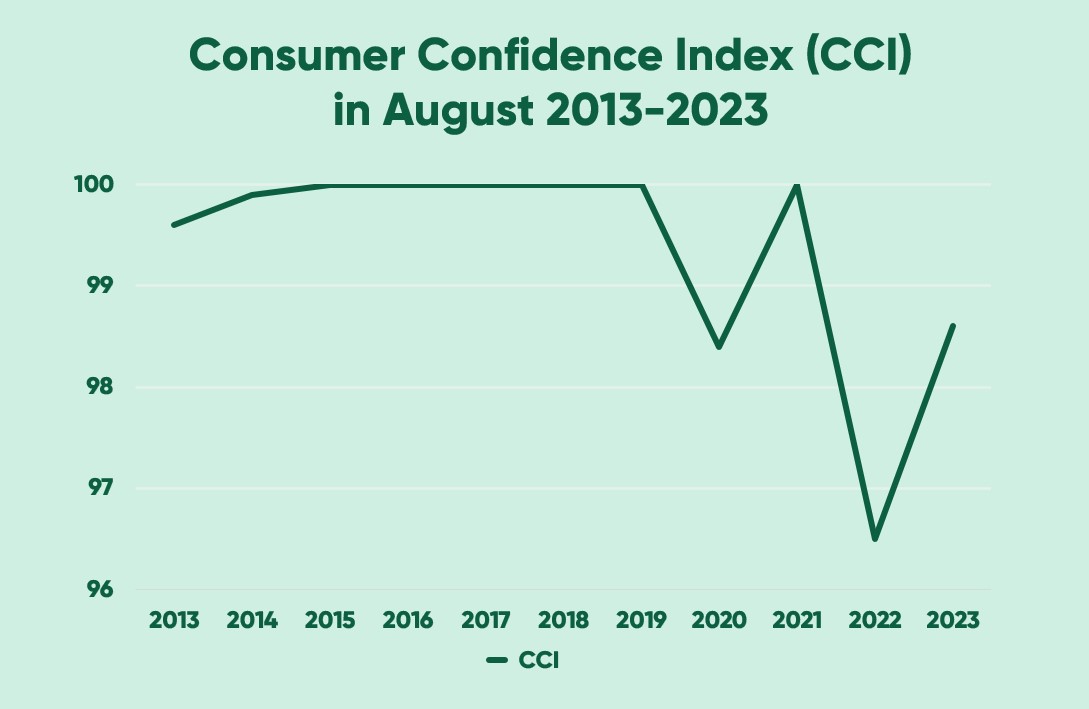
With consumer confidence low, customers are more cautious with their spending and more prone to switching to competitors for a better price.
In this context, it's crucial you build loyalty and create situations where shopping guilt is replaced with shopping glee. There’s no better way to do this than by getting customers excited and ensuring they come away from a purchase feeling like they got their hands on a great deal or limited-edition product—which can be achieved with scarcity and hype.
These trends boil down to the importance of creating and nurturing loyalty. There’s more competition, a longer holiday season with more events, and consumers are looking to save in whatever ways they can.
Loyalty can mitigate how much your brand is impacted by these external factors. Loyal customers are your best asset:
- 65% of a company’s revenue comes from the repeat business of existing customers
- 57% of consumers spend more with brands they’re loyal to
- Brands that offer positive experiences receive 3 times more word-of-mouth marketing than brands that offer dull experiences
RELATED: 79 Staggering Statistics That Show the Power of Loyalty Programs
Big brands know the value of loyalty and are leveraging the loyalty-building power of loyalty programs and shopping events for holiday season success.
Ecommerce loyalty programs are a way of strengthening relationships between brands and consumers. They're a more formalized type of brand loyalty, as it’s not just a customer regularly shopping with a brand, it’s a customer who subscribes to newsletters, or pays for benefits, or tries to rack up loyalty points and benefits.
What’s the best way to encourage loyalty program sign-ups?
High visibility and high demand contexts like shopping events.
And with the holiday season getting longer, your shopping events can be much more than just Black Friday and Cyber Monday sales.
Examples of shopping events
- Flash sales
- Product drops
- Invite-only, early access & member sales
- Daily deals
- Limited-edition goods & collaborations
- High demand product restocks
- Live-streamed shopping
By creating more online shopping events like these, retailers are bringing to ecommerce the social proof and hype that comes from people lining up outside a store.
They’re personalizing shopping in the ways a retail assistant would.
They’re leveraging the feelings of anticipation, excitement, and competition that accompany major sales and product drops to boost loyalty and brand affinity. One report showed:
- 43% of consumers have participated in product drops, flash sales & private sales in the past month
- 45% of consumers are interested in product drops because they value access to products that are difficult to obtain
- 67% of consumers increased brand affinity after product drops
Those two last stats are very important.
First, almost half of consumers want products that are difficult to obtain.
This is why we see sports brands release sneakers in a new limited-edition color every week and brands like McDonald’s making limited-edition collaborative meals. There’s no real shortage of Air Maxs or Quarter Pounders, so Nike and McDonald’s make artificial shortages to get customers excited.
RELATED: Everything You Need to Know About Product Drops: Strategies, Benefits & Examples
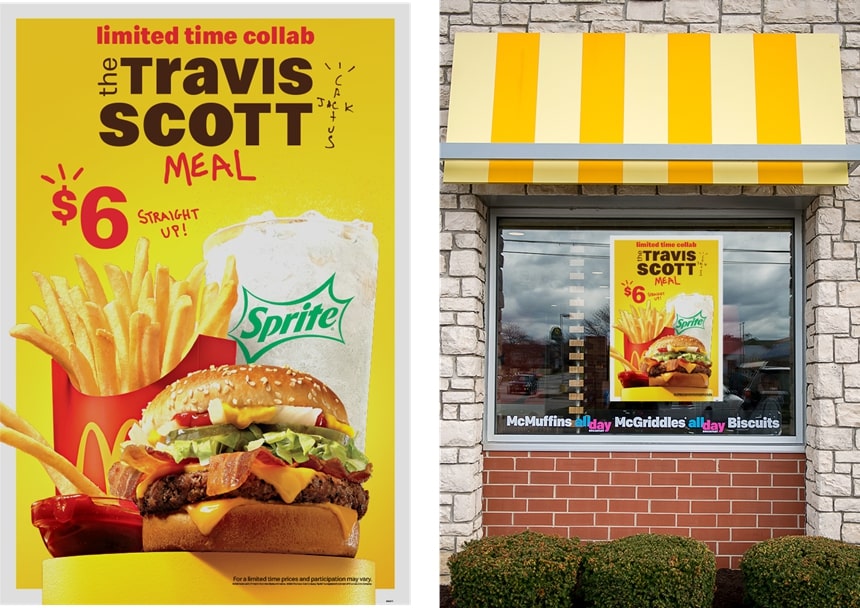
Second, most customers who participate in product drops feel increased brand affinity.
Product drops give customers a strong sense of anticipation, an increased desire for possessing the product, and a drive to constantly check the website and social media of the brand before the product drops.
RELATED: The Power of Anticipation Psychology & How To Use It for Ecommerce Marketing
Product drops & flash sales create a different feeling in customers than just clicking an ad and purchasing a product. They leave customers feeling closer to the brand and more satisfied—which is key to keeping their loyalty.
Get a free interactive checklist for successful product drops
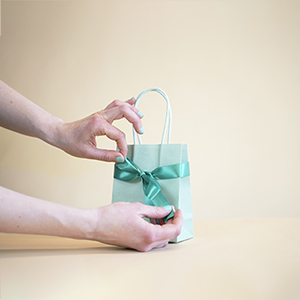
Now we’ve established why leveraging scarcity and hype is so important for the new holiday season landscape, let’s look at how online retailers can set themselves up for success.
The following six strategies cover the tactics major retailers use to capture loyalty and attention on their biggest days and throughout the year. Discover how you can use scarcity and shopping events to generate hype, and how you can prepare your site to deliver on demand.
Black Friday flash sales, and all flash sales, succeed based on a simple principle: the scarcer something is, the more people want it.
When this principle is used in marketing, it’s called scarcity marketing.
Scarcity marketing is a strategy used by businesses to increase the perceived value of products by reducing supply. This can be done by reducing the supply of products (e.g., only 100 sneakers available), or by creating scarcity around offers on products (e.g., 40% off sneakers for one day only).
The powerful effects of scarcity marketing are based on FOMO, fear of missing out. In these examples, the perceived scarcity increases your sense of urgency and desire. You think “I might never have this chance again.”
RELATED: 7 Simple Scarcity Marketing Strategies to Supercharge Ecommerce
No one wants to miss out on a good deal; people want products they might never get the chance to buy again.
Let’s look at an example.
Whether intentionally or not, Sony has benefitted from the scarcity of PS5s.
For almost 2 years, every PS5 that’s gone onto the market has been quickly snatched up.
If you go to their site, you’ll see this page showing PS5s are sold out, and offering an email form for people to sign-up to be notified about restocks.
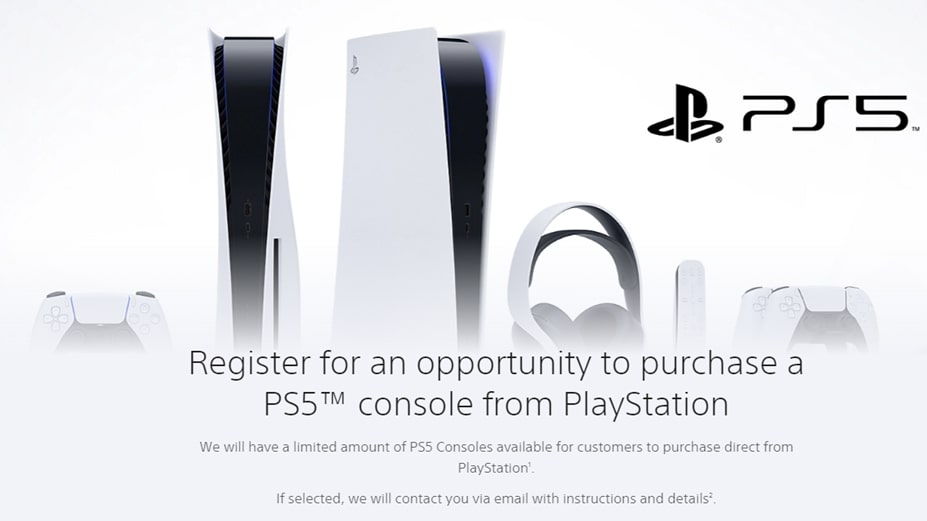
You can see touches of scarcity marketing in the language on this page. Customers are asked to register for an opportunity at a limited amount of PS5s, and if selected, Sony will be in touch.
This sign-up page gives Sony a huge mailing list of people who want PS5s. So when they’re preparing for a restock, they already have thousands of expressions of interest.
They send out the emails and customers rush to the site and see a page with a countdown timer, building anticipation.
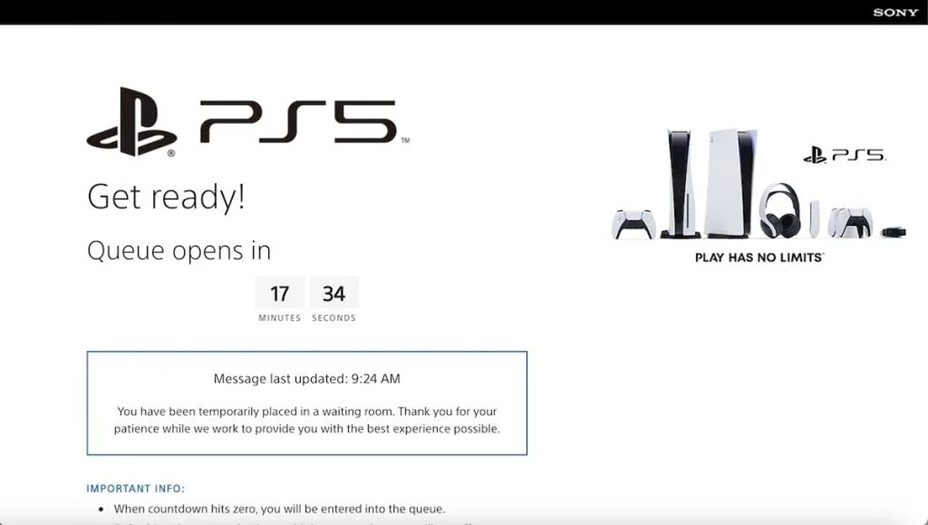
Buzz builds on social media as people Tweet about the restock.
When the sale goes live, customers queue for the product digitally, recreating the social proof and competition that accompanies real-world queues
By the time a customer reaches the product page and checks out, they feel like they’ve won a prize.
With this strategy, Sony is selling a product at full retail price, and customers still feel that they’re winning by getting their hands on one.
Scarcity marketing magic at work.
We’ve seen this with our own customers, who’ve observed large increases in conversion rates while using a virtual waiting room like the one above.
"Because there was a queue, we saw an enormous increase in conversion rates. People think, 'Now that I’m on the site, I really need to buy something.'"
Joost Van Der Veer, CEO

Black Friday sales succeed based on scarcity. People camp out, line up, and spend more than on any other day of the year—all because they believe they’ll save more than on any other day of the year.
The scarcity that fuels Black Friday sales is scarcity of offers, meaning large discounts offered for one day only. The downside of this is that retailers accept lower profit margins on Black Friday in exchange for higher total sales volume.
But the PS5 example above shows that scarcity marketing can succeed without heavy discounts.
Retailers are achieving this with a product drop strategy.
Not to be confused with a product launch, product drops are more frequent sales or restocks of limited-release, limited-edition products.
Think sneakers in a new colorway. Brand collaborations. Restocks of customer favorites.
The product drop model throws discount-based scarcity out the window and instead allows retailers to harness scarcity without sacrificing their margins.
45% of consumers are interested in product drops because they value access to products that are difficult to obtain. The product drop model helps brands:
- Generate hype
- Create headlines
- Encourage loyalty program sign-ups
- Boost brand affinity
- Increase sales
Sneaker brands lead the pack in scarcity-based product drops.
Just about every popular sneaker brand has a calendar of limited-edition shoes that’ll be releasing over the coming months.
Instead of designing entirely new shoes, they’ll tweak a few colors or bring in a high-profile collaborator and they’re left with a product customers are scrambling to get their hands on.
There are massive online communities discussing the sneakers, huge resale markets for them, and seemingly endless free marketing and PR for big brands like Nike, New Balance, and Adidas.
Let’s look at an example.
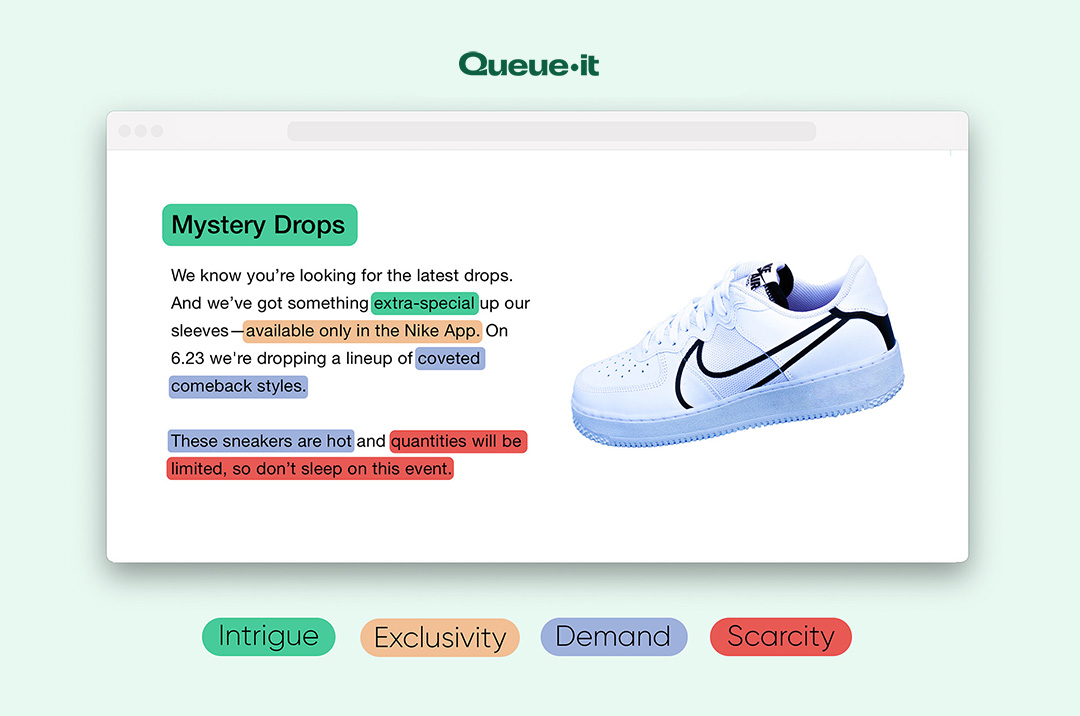
In the above piece of marketing collateral from Nike, you can see several key scarcity marketing and product drop strategies:
- Intrigue: “Mystery drops”
- Social proof: “These sneakers are hot” and “coveted”
- Scarcity: “quantities will be limited”
- Exclusivity: “available only in the Nike app”
Nike knows these product drops are their key opportunity to capture loyalty among customers who typically buy their sneakers from other retailers. That’s why the drop model has been at the core of Nike’s highly successful direct-to-consumer shift in recent years.
In the above example, if you want these shoes, you need to download the Nike app and register for the drop. The scarcity and hype around the “mystery drops” means thousands will download the app and try their luck. With this, Nike gets:
- The Nike app on customers’ phones
- The email addresses and account details of customers
- The opportunity to deliver a superior customer experience
- Marketing intelligence and data on the level of interest in different sneaker models
The true benefit of this “Mystery drop” for Nike isn’t the revenue from the sneakers, it’s the customer connections and relationships formed.
Product drop examples across industries
Although most prominent in the sneaker and streetwear worlds, the product drop model is making its way into many other industries:
- DoorDash recently announced access to exclusive product drops as part of their product subscription.
- Prada now does monthly product drops, releasing one new product each month that’s only available for a 24-hour window.
- Tech startup Stir has started software product drops, releasing simple but useful one-off pieces of software, like OnlyTweets, which lets Twitter users put their account behind a paywall.
- MSCHF is a brand that does nothing but drops, dropping everything from new fonts to alcoholic drinks to Tiffany & Co. collaborations.
- Kim Kardashian’s SKIMS and Kylie Jenner’s Kylie Cosmetics have skyrocketed to success through product drops and restocks that consistently sell out.
- Drops are essentially the only sales method used for NFTs.
- Video games like Fortnite regularly drop limited-time in-game experiences.
- Even Twitter announced they’ll be incorporating product drop functionality into their service, letting customers sign up for drop reminders within the app.
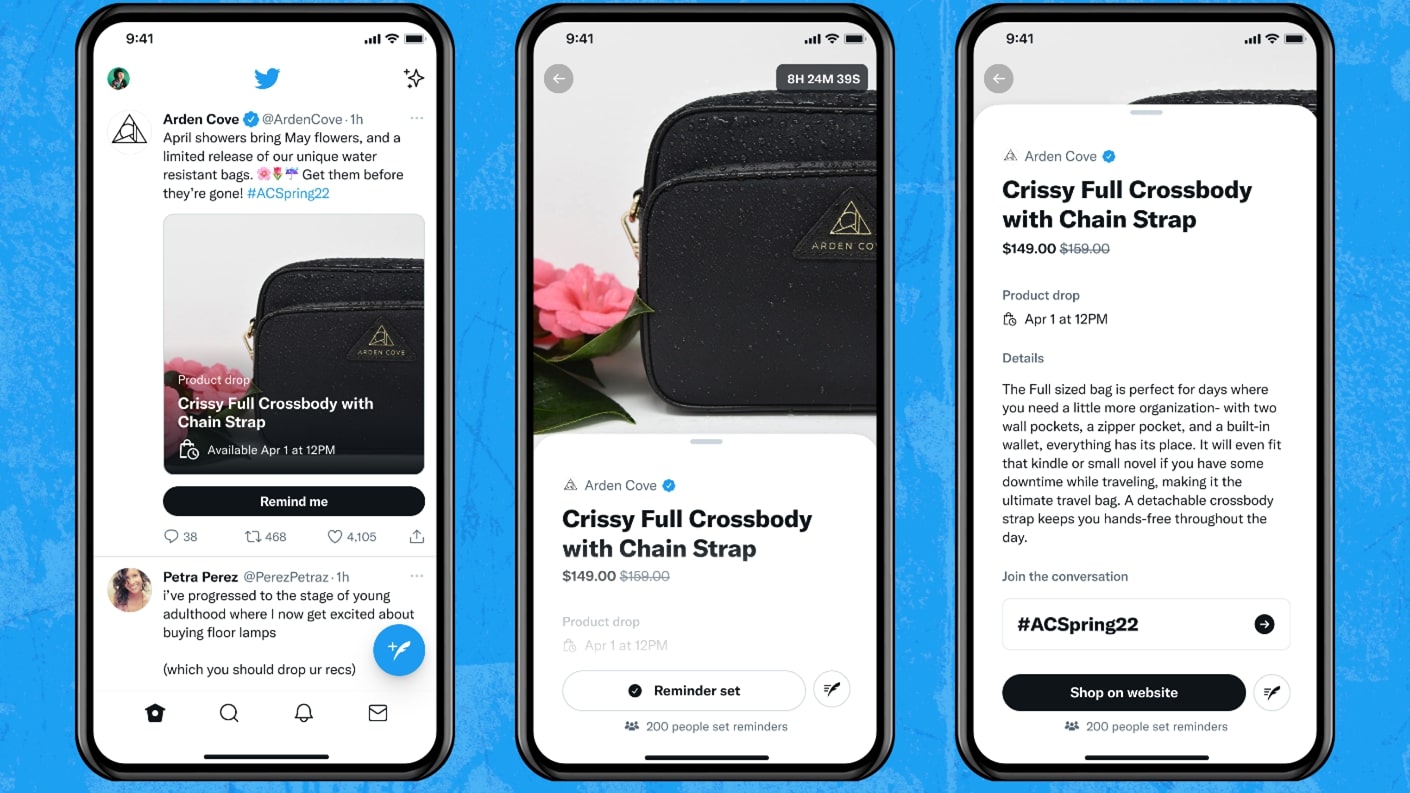
Member, early access, and invite-only sales work like the product drop model to build brand loyalty and encourage loyalty program members.
The core idea here is to add an extra layer of exclusivity to sales or product drops by granting select groups special access. These groups might be:
- VIP/high value customers
- Customers with paid subscriptions
- Customers who are part of a loyalty program
- Social media followers
- Customers who recently missed out on an item
- Newsletter subscribers
Just as Nike uses hyped sneaker drops to get people to download their app, invite-only sales serve as a key value proposition for customers to engage in loyalty programs with your brand.
The upside of this is huge. 70% of consumers spend more with brands when they’re part of a loyalty, member, or subscription program.
And the downside is minimal. You can run sales or product drops just as you usually would, the only difference being you give a select group first access.
RELATED: Ecommerce Loyalty Programs: How To Keep Customers Coming Back for More
Member and invite-only sales have many benefits, they:
- Enable you to encourage brand loyalty and reward loyal customers
- Give extra value to customers who subscribe to your newsletter
- Allow you personalize sales to make customers feel seen
- Make paid memberships & subscriptions worthwhile for customers, especially if they’re given exclusive access to a new product before everyone else
- Let you utilize scarcity marketing and exclusivity, making your best customers feel they have an exclusive chance to get in before everyone else.
You can see how this strategy can be paired with scarcity marketing in the example from Walmart below.
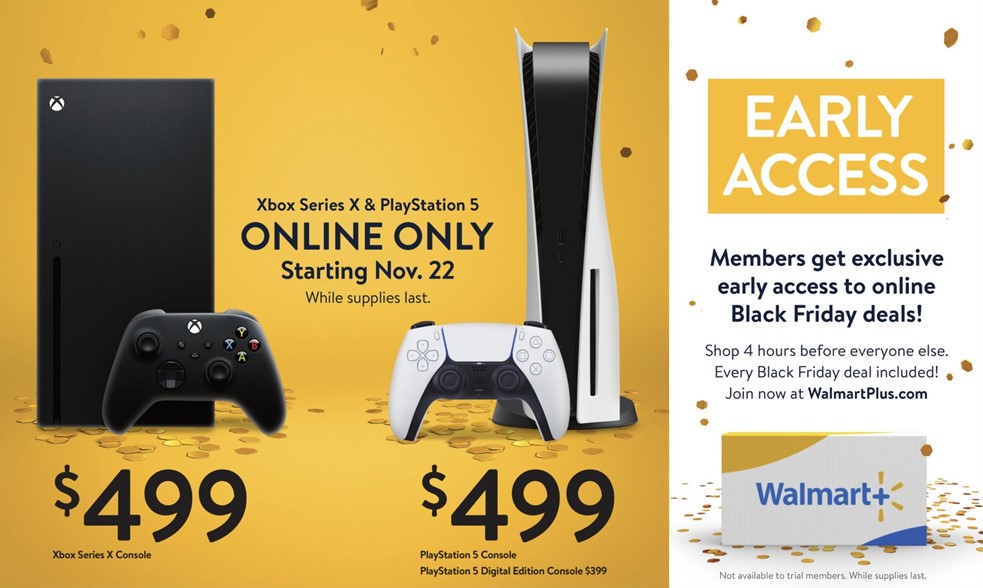
In this example, Walmart uses the scarcity of popular consoles to encourage sign ups to their WalmartPlus subscription service.
Members who sign up get first access and are pleased, and Walmart gets thousands of new members who not only pay $13 a month but are likely to spend more with Walmart thanks to other benefits of their membership program.
RELATED: Roll Out the Red Carpet for Loyal Customers with Exclusive Invite-only Sales & Drops
Target also does these early access member sales, as does BestBuy, as does Nike. They’re a no brainer for making the most out of your Black Friday sales and holiday season product drops.
Discover how you can break Black Friday sales records without breaking your site

You can’t talk about hype and social proof in 2023 without talking about social media.
The global influencer market size has more than doubled since 2019. In 2023, the market was estimated at a record $21.1 billion. Product reviews and try on hauls garner millions of organic views and drive massive sales for brands. Trending items on TikTok crash websites and clear out stock.
These influencer and social shopping trends are closely tied to the strategies we’ve discussed above. Many products launched though social media are designed to sell out.
RELATED: Exclusive Fenty by Rihanna Drop Sends Record Traffic to Harvey Nichols
Take social media veteran Kim Kardashian, for example, whose brand SKIMS has made her a billionaire.
Kardashian’s SKIMS sells products entirely through a product drop business model. New products and restocks are dropped weekly in batches of between 20,000 and 200,000 that are designed to sell out fast.

This model means thousands of customers miss out on the first sale. The media publishes headlines about an instant sell out. Interest builds. Those who get the products feel like they’re part of an exclusive club, and start posting unboxing videos, reviews, and photos and videos with the clothes on. The people who missed out and are waiting for a restock consume this content and their desire for the goods grows.
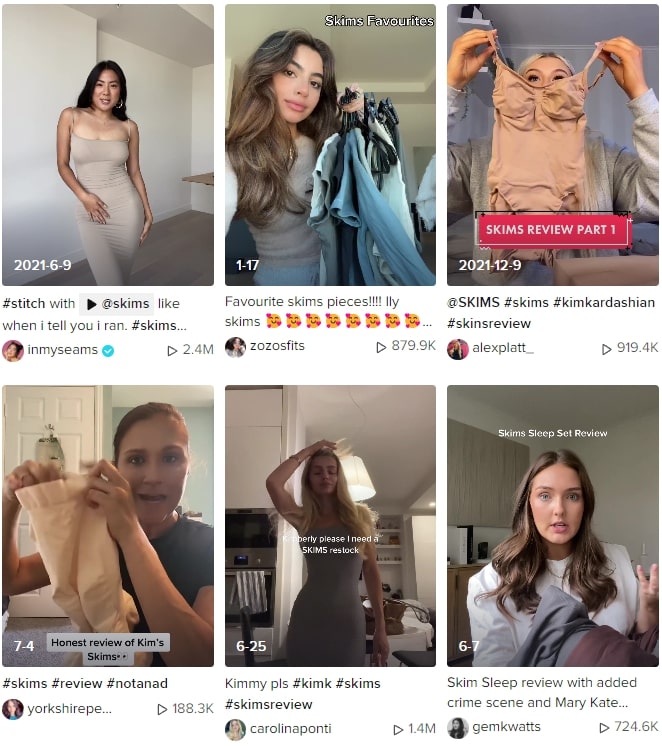
By the time the next release or restock drops, hype has built, the new collection sells out, and the cycle continues.
RELATED: Your Influencer Marketing Strategy for Product Launches in 6 Simple Steps
But it’s not just the world’s biggest social media stars that can leverage the power of these new platforms. The beauty of social media is there are so many niche communities and hyper-specialized influencers.
Easho, one of our clients, sells health and beauty products, office supplies, and bathroom essentials in bulk. They teamed up with home cleaning and design influencer @mrshinchhome for a custom flash sale and saw over 54,000 shoppers visit their site for the 4-hour sale.
When done right, social media marketing lets you reach the right audience, personalize the experience, generate hype, and create a sense of exclusivity around your sale or product drop.
For the second half of this list, we’ll move from generating hype to delivering on demand. This means understanding how to get these high-stakes sales right.
One of the most important things online retailers can do before the holiday season is ensure their websites are prepared for high demand.
Black Friday is the biggest day of the year for ecommerce. In 2022, site traffic on Black Friday was 3 times higher than a regular October day, and more than 30% higher than the next biggest day of the season.
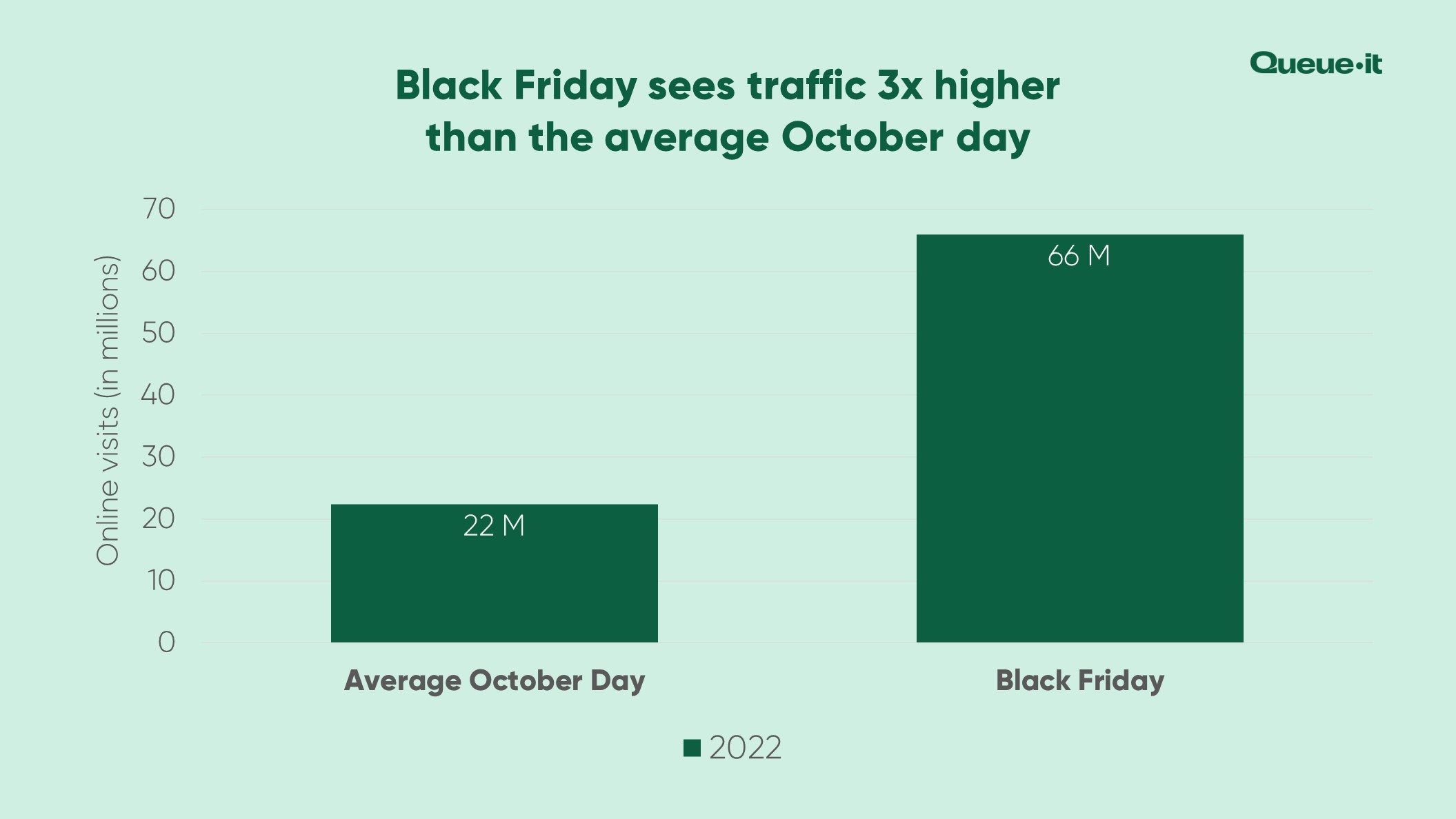
RELATED: Holiday Shopping Statistics 2022: Data from 1.7 Billion Web Visits
But with the holiday season landscape changing, it’s not just big sales days that drive major traffic. Successful product drops, flash sales, and restocks are also huge drivers of online traffic. In fact, almost every example we’ve used in this piece—from PS5s to Nike Sneakers to SKIMS dresses—have caused site crashes.
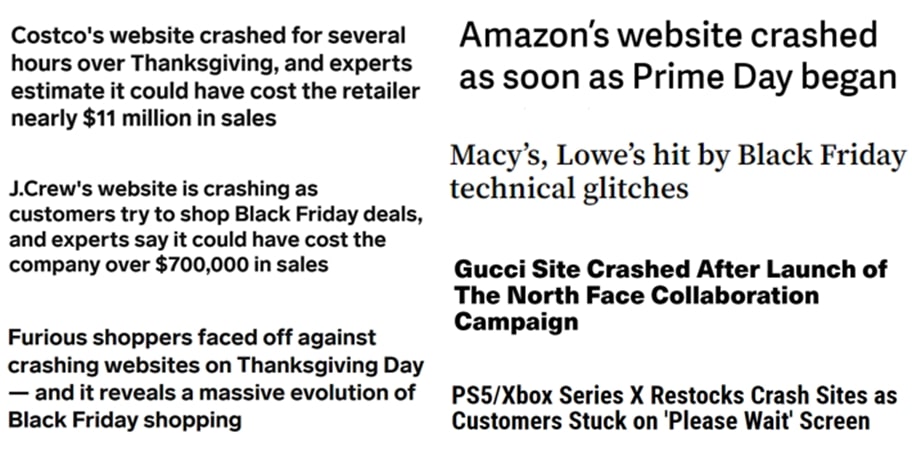
RELATED: How High Online Traffic Can Crash Your Website
Here’s a behind-the-scenes look at a major sneaker retailer’s traffic during a hyped product drop. Within half an hour, traffic jumps 10x from below a thousand site visitors per minute to over 9,000 visitors per minute.
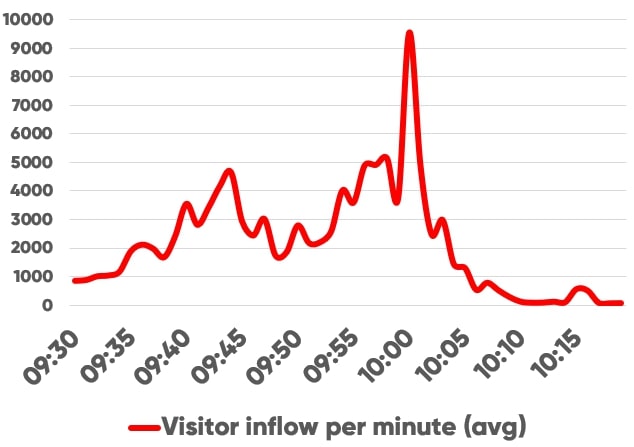
When hyped flash sales and product drops are part of your loyalty building strategy, it’s essential you deliver on your promise to customers. Website crashes can cost millions, and have even further reaching impacts on consumer trust and loyalty.
PwC reports a massive 1 in 3 customers will leave a brand they love after just one bad experience. Another survey found almost half (46%) of Brits will stop shopping with a retailer altogether if its mobile app crashes on Black Friday.
The impacts of crashes & slowdowns are far-reaching:
- Lost hype
- Missed sales opportunities
- Poor user experience
- Damaged brand reputation
- Wasted marketing budget
- Diverted internal resources
RELATED: The Cost of Downtime: IT Outages, Brownouts & Your Bottom-line
LiveGlam, who frequently run influencer marketing campaigns, flash sales, and product drops, were experiencing site issues caused by high traffic.
They were concerned not just about the large costs of downtime, but also about threats to their partnerships and credibility. Their director of Operations & business development said:
"Downtime of even one to two seconds can be very costly. When you multiply that by 60,000-100,000 people, that adds up. Whenever anyone else is involved as well, influencers or another brand, we don't want to affect how their audiences view them."
Alex Wakim, DIRECTOR OF OPERATIONS & BUSINESS DEVELOPMENT

Quick tips for preparing for high traffic:
- Load test ahead of major sales days to know what you can handle
- Cache static content on your CDN and run content on the Edge
- Identify site bottlenecks such as payment gateways and database calls
- Use a virtual waiting room to manage the flow of traffic to your site
For a deeper dive into preparing for high demand holiday season sales, download your free Black Friday Guide.
One of the few downsides to the strategies in this article is that a successful combination of scarcity and hype attracts bots and resellers. Where supply and demand are mismatched, people will seek ways to exploit that mismatch and profit off your success.
Bot traffic spiked 50% during Cyber Week in 2022. And bots and resellers specifically target sales that combine scarcity and hype—in one limited-edition sneaker release, 71.6% of all traffic was found to be bots.
But why does this matter? After all, a sale’s a sale right?
This is a question many businesses face. While a one-off product drop or flash sale selling out immediately is typically seen as a success, bots pose a major risk to several key drivers of ecommerce success.
From negatively affecting customer loyalty to damaging brand reputation to skewing analytics and spiking ad spend—when you’re selling to bots, a sale’s not just a sale.
The negative impacts of bots include:
- Tarnished brand image
- Missed connections with true customers
- Jeopardized business contracts
- Increased operational & support costs
- Faulty analytics for decision-making
- Website crashes & slowdowns
The key issue with bots ties back to the importance of building brand loyalty. The strategies in this article do very little to build brand loyalty if you sell your products exclusively to bots.
Scarcity marketing doesn’t work if customers feel they have zero chance of getting the product. Member-only sales aren’t special if they’re teeming with bots. Social media marketing is useless if the public turns against you.
RELATED: Customer Loyalty in Ecommerce: The Surprising Benefits of Fairness

When customers are forced to buy products for huge markups on secondary markets, they feel let down and lied to, and they’ll blame you the retailer. This breaks down trust, which impacts satisfaction and loyalty.
RELATED: Everything You Need to Know About Preventing Online Shopping Bots
Worst of all, if you’re offering Black Friday discounts that make your products margin-negative in the hopes of gaining new customers, letting bots snatch them up just means you’re bleeding money without reaping the benefits of those customer connections.
So how can you stop bots from exploiting your sales?
Quick tips for blocking retail bots:
- Use tools to monitor and identify bot traffic
- Use CAPTCHAs
- Block suspicious IP addresses
- Block outdated browser types
- Run a post-sale audit to identify orders to the same address or using the same credit card
- Use bot mitigation and web traffic management software
For a deeper explanation of these points, and everything else you need to know to prevent retail bots, get your free retail bots guide.
If you want to stand out this holiday season, it’s no longer enough to just discount products on Black Friday. The brands that are seeing major success throughout the holiday season—and the rest of the year—are adapting and embracing scarcity marketing and hype.
There are three main reasons these loyalty-generating strategies are essential for gaining competitive advantage this holiday season:
- Ecommerce growth means more competition and a loss of the social proof and urgency of brick-and-mortar shopping.
- A longer holiday season means reaching customers for one day isn’t enough, you need to keep your brand top of mind to reap the benefits.
- Low consumer confidence makes consumers more open to switching brands and more likely to buy products they see as special.
To use scarcity and exclusivity to generate hype, and prepare your site to deliver on demand, there are six key strategies major retailers are embracing:
- Tap into scarcity marketing
- Shift scarcity from discounts to drops
- Nurture loyalty with member, early access & invite-only sales
- Build hype by taking shopping social
- Ensure your site delivers on demand
- Block bots & resellers for a fairer customer experience
